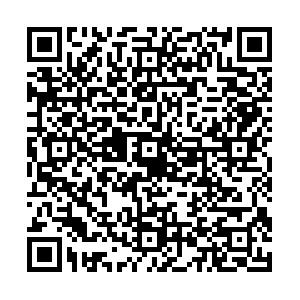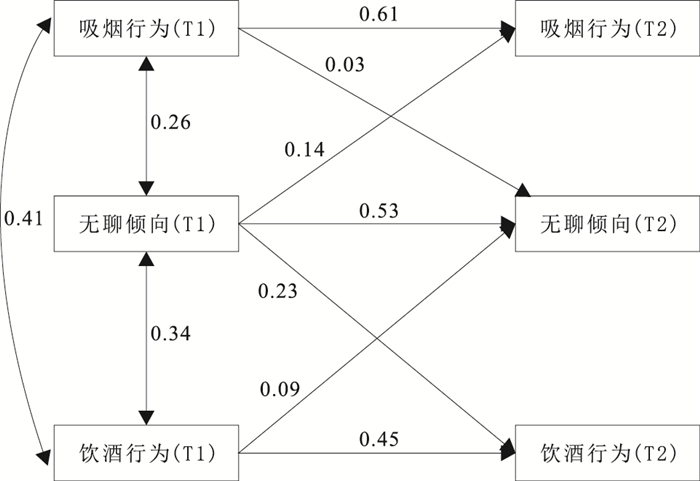Cross-lagged analysis of boredom proneness and smoking, drinking behavior among adolescents
-
摘要:
目的 了解青少年无聊倾向与吸烟、饮酒行为的发展变化及相互关系,为后续研究及干预提供研究资料。 方法 采用单维短式无聊倾向量表、吸烟和饮酒行为量表,对方便抽取的内蒙古自治区1所高中和1所大学的416名学生进行间隔12个月的两阶段追踪调查。 结果 无聊倾向与吸烟、饮酒行为在两阶段的测量中均呈正相关(第1次测量r值分别为0.30,0.34;第2次测量r值分别为0.24,0.45,P值均<0.01);无聊倾向和吸烟、饮酒行为的自回归路径系数均有统计学意义(β值分别为0.53,0.61,0.45,P值均<0.01);无聊倾向能够预测12个月后的吸烟行为(β=0.12,P<0.01),而吸烟行为不能预测12个月后的无聊倾向(β=0.03,P>0.05);无聊倾向能够预测12个月后的饮酒行为(β=0.21,P<0.01),且饮酒行为能够预测12个月后的无聊倾向(β=0.09,P<0.05)。 结论 青少年无聊倾向与吸烟、饮酒行为关系密切,无聊倾向能正向预测吸烟和饮酒行为,且饮酒行为能正向预测无聊倾向。 Abstract:Objective To explore the development and interactive correlations between boredom proneness, smoking and drinking behavior. Methods A total of 416 adolescents from one senior high school and one college in the Inner Monggol Autonomous Region were recruited to complete the short-version boredom proneness scale, as well as smoking and drinking behavior scale at baseline and in the 12 month follow-up. Results There were significant and positive correlation between boredom proneness and smoking and drinking behavior at both cross sectional levels (T1 r=0.30, 0.34, T2 r=0.24, 0.45, P < 0.01). Significant autoregressive coefficients were observed for boredom proneness, smoking and drinking behavior in adolescents (β=0.53, 0.61, 0.45, P < 0.01). Moreover, the cross-lagged analyses revealed that the relationship between bordom proneness and smoking behavior was unilaterally influencing (β=0.12, P < 0.01; β=0.03, P > 0.05), the relationship between bordom proneness and drinking behavior was bidirectional over the 12 months (β=0.21, 0.09, P < 0.05). Conclusion Boredom proneness of adolescents is closely related to smoking and drinking behavior, boredom proneness can positively predict smoking and drinking behavior, and drinking behavior can positively predict boredom proneness. -
Key words:
- Mental health /
- Smoking /
- Alcohol drinking /
- Adolescent
1) 利益冲突声明 所有作者声明无利益冲突。 -
表 1 无聊倾向、吸烟和饮酒行为的相关性分析(r值,n=416)
Table 1. Correlation analysis of boredom proneness, smoking and drinking behavior(r, n=416)
变量 无聊倾向T1 无聊倾向T2 吸烟行为T1 吸烟行为T2 饮酒行为T1 无聊倾向T2 0.55 吸烟行为T1 0.30 0.14 吸烟行为T2 0.28 0.24 0.58 饮酒行为T1 0.34 0.23 0.39 0.32 饮酒行为T2 0.41 0.45 0.30 0.36 0.43 注: P值均 < 0.01。 -
[1] XIAO D, WANG C. Rising smoking epidemic among adolescents in China[J]. Lancet Respir Med, 2019, 7(1): 3-5. doi: 10.1016/S2213-2600(18)30509-5 [2] 卢士军. 六城市青少年饮酒行为调查及其防控策略研究[D]. 北京: 中国疾病预防控制中心, 2015.LU S J. Drinking behavior survey and control strategy study in adolescents in six Chinese cities[D]. Beijing: Chinese Center for Disease Control and Prevention, 2015. [3] BAHRS M, SCHUMANN M, ZIMMERMANN K F. Unlucky to be young? The long-term effects of school starting age on smoking behavior and health[J]. J Popul Econ, 2020, 33(2): 555-600. doi: 10.1007/s00148-019-00745-6 [4] TYROVOLAS S, PANARETOS D, DASKALOPOULOU C, et al. Alcohol drinking and health in ageing: a global scale analysis of older individual data through the harmonised dataset of ATHLOS[J]. Nutrients, 2020, 12(6): 1746. doi: 10.3390/nu12061746 [5] ERTUZUN E E, LAPA T Y. Relationship between adolescents' leisure boredom and substance use in Turkey[J]. TUR J Sport Exerc, 2020, 22(3): 374-383. [6] BIOLCATI R, MANCINI G, TROMBINI E. Proneness to boredom and risk behaviors during adolescents' free time[J]. Psychol Rep, 2018, 121(2): 303-323. doi: 10.1177/0033294117724447 [7] 王宏, 张守臣, 刘秀荣, 等. 青少年休闲无聊与烟酒使用行为的关系: 抵制效能感的中介作用和调节作用[J]. 中国临床心理学杂志, 2018, 26(4): 757-762. https://www.cnki.com.cn/Article/CJFDTOTAL-ZLCY201804027.htmWANG H, ZHANG S C, LIU X R, et al. Leisure boredom and tobacco and alcohol use: refusal self-efficacy as a mediator and moderator[J]. Chin J Clin Psychol, 2018, 26(4): 757-762. https://www.cnki.com.cn/Article/CJFDTOTAL-ZLCY201804027.htm [8] MARTINEZ-VISOP C, SENRA C, LOPEZ-DURAN A, et al. Boredom susceptibility as predictor of smoking cessation outcomes: sex differences[J]. Pers Individ Dif, 2019, 146: 130-135. doi: 10.1016/j.paid.2019.03.026 [9] 俞国良, 张亚利. 青少年无聊的心理效应与应对: 心理健康视角[J]. 山西师大学报(社会科学版), 2021, 48(4): 95-101. https://www.cnki.com.cn/Article/CJFDTOTAL-SXSK202104012.htmYU G L, ZHANG Y L. The psychological effect and countermeasures of teenagers' boredom: from the perspective of mental health[J]. J Shanxi Norm Univ (Soc Sci Edit), 2021, 48(4): 95-101. https://www.cnki.com.cn/Article/CJFDTOTAL-SXSK202104012.htm [10] 刘勇, 王云龙, 赵建芳, 等. 大学生无聊倾向抵制效能感与烟酒使用行为的关系[J]. 中国学校卫生, 2018, 39(4): 560-562. doi: 10.16835/j.cnki.1000-9817.2018.04.023LIU Y, WANG Y L, ZHAO J F, et al. Relationship between boredom proneness with refusal self-efficacy and tobacco and alcohol use among college students[J]. Chin J Sch Health, 2018, 39(4): 560-562. doi: 10.16835/j.cnki.1000-9817.2018.04.023 [11] PETTIFORD J, KOZINK R V, LUTZ A M, et al. Increases in impulsivity following smoking abstinence are related to baseline nicotine intake and boredom susceptibility[J]. Addict Behav, 2007, 32(10): 2351-2357. doi: 10.1016/j.addbeh.2007.02.004 [12] MOYNIHAN A B, IGOU E R, VAN TILBURG W A P. Existential escape of the bored: a review of meaning-regulation processes under boredom[J]. Eur Rev Soc Psychol, 2021, 32(1): 161-200. doi: 10.1080/10463283.2020.1829347 [13] PROCHASKA J J, DAS S, YOUNG-WOLFF K C. Smoking, mental illness, and public health[J]. Ann Rev Public Health, 2017, 38: 165-185. doi: 10.1146/annurev-publhealth-031816-044618 [14] 曲亚斌, 沈少君, 袁华晖, 等. 广东省2007—2016年青少年物质滥用行为变化趋势[J]. 中国学校卫生, 2020, 41(11): 1650-1653. doi: 10.16835/j.cnki.1000-9817.2020.11.014QU Y B, SHEN S J, YUAN H H, et al. Trends of substance abuse behavior among adolescents in Guangdong Province, 2007-2016[J]. Chin J Sch Health, 2020, 41(11): 1650-1653. doi: 10.16835/j.cnki.1000-9817.2020.11.014 [15] 彭嘉熙, 彭鑫鹏, 黄荷, 等. 单维短式无聊倾向量表在大学生群体的信效度检验[J]. 中国临床心理学杂志, 2019, 27(2): 282-285. https://www.cnki.com.cn/Article/CJFDTOTAL-ZLCY201902015.htmPENG J X, PENG X P, HUANG H, et al. Reliability and validity test of the Chinese version of short boredom proneness scale[J]. Chin J Clin Psychol, 2019, 27(2): 282-285. https://www.cnki.com.cn/Article/CJFDTOTAL-ZLCY201902015.htm [16] 叶宝娟, 李董平, 陈启山, 等. 青少年感觉寻求与烟酒使用的关系: 一个有中介的调节模型[J]. 心理发展与教育, 2011, 27(4): 417-424. https://www.cnki.com.cn/Article/CJFDTOTAL-XLFZ201104013.htmYE B J, LI D P, CHEN Q S, et al. Sensation seeking and tobacco and alcohol use among adolescents: a mediated moderation model[J]. Psychol Dev Educ, 2011, 27(4): 417-424. https://www.cnki.com.cn/Article/CJFDTOTAL-XLFZ201104013.htm [17] ZHANG Y, LI S, YU G. The longitudinal relationship between boredom proneness and mobile phone addiction: evidence from a cross-lagged model[J]. Current Psychol, 2021(2): 1-8. [18] TWYMAN L, BONEVSKI B, PAUL C, et al. Perceived barriers to smoking cessation in selected vulnerable groups: a systematic review of the qualitative and quantitative literature[J]. BMJ Open, 2014, 4(12): e006414. doi: 10.1136/bmjopen-2014-006414 [19] SHALCHI B, KHOOY M P. Satisfaction of basic psychological needs in patients with substance use disorder and normal persons: a research based on self-determination theory[J]. Hormozgan Med J, 2019, 23(2): e86440. [20] WEGNER L, FLISHER A J, MULLER M, et al. Leisure boredom and substance use among high school students in South Africa[J]. J Leis Res, 2006, 38(2): 249-266. doi: 10.1080/00222216.2006.11950078 [21] ELPIDOROU A. The bored mind is a guiding mind: toward a regulatory theory of boredom[J]. Phenomenol Cogn Sci, 2018, 17(3): 455-484. doi: 10.1007/s11097-017-9515-1 [22] GROGAN S, WALKER L, MCCHESNEY G, et al. How has COVID-19 lockdown impacted smoking? A thematic analysis of written accounts from UK smokers[J]. Psychol Health, 2022, 37(1): 17-33. doi: 10.1080/08870446.2020.1862110 [23] 朱晨迪. 基于结构协变网络评价尼古丁依赖者脑结构损伤机制研究[D]. 郑州: 郑州大学, 2018.ZHU C D. The study of brain damage in nicotine dependent subjects based on structural covariance network[D]. Zhengzhou: Zhengzhou University, 2018. [24] SLATER M D, SHEHATA A, STROMBACK J. Reinforcing spirals model[J]. Int Enc Med Psychol, 2020(6): 1-11. -







 下载:
下载:

